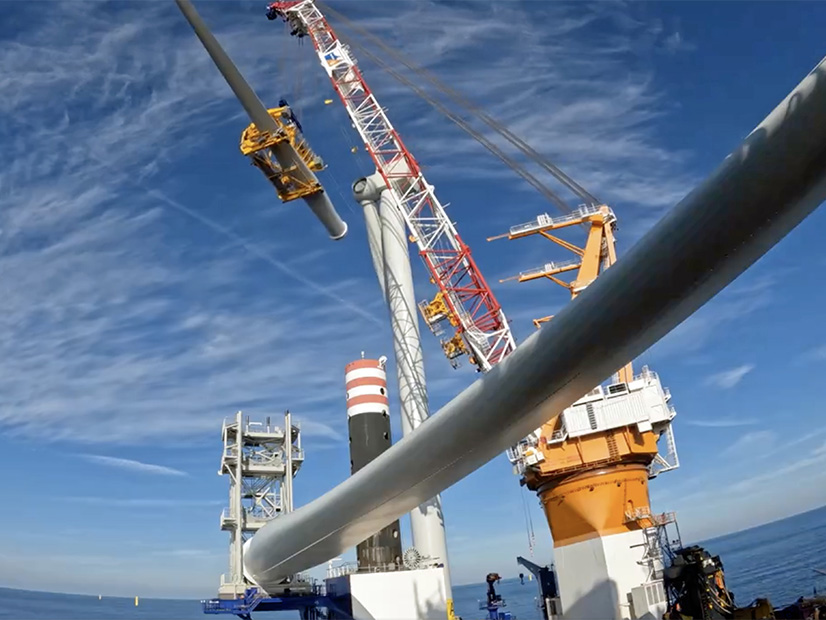
Eversource Energy has finalized its long-running attempt to sell off its offshore wind assets, but not soon enough to avoid a $1.95 billion impairment for 2023.
If the moving pieces come together as planned, the New England utility will be done with the struggling offshore wind sector, though it will continue to lead onshore transmission infrastructure work for the projects underway in its joint venture with Ørsted.
Eversource announced the sale to Global Infrastructure Partners (GIP) after the financial markets closed Feb. 13, along with its fourth-quarter and full-year financials. Its stock, which has been trading near a five-year low, closed 4.7% higher in heavier-than-average trading Feb. 14.
Eversource also said it will begin to evaluate market interest for Aquarion Water, the sale of which would bring an infusion of cash without resorting to the equity market.
The sale of the offshore wind interests and the water utility would refocus the company on natural gas and electric transmission and distribution, which now provide the vast majority of its earnings.
The Ørsted-Eversource venture has not been a failure: The partners expect to finish the nation’s first utility-scale offshore wind farm — South Fork Wind — next month, have begun construction of Revolution Wind and are far along in planning for Sunrise Wind. But the effort has been much more costly than expected, causing billions in losses for both.
Ørsted, the world’s leading offshore developer, is pushing forward with some cutbacks. (See Ørsted Exits Offshore Wind Markets, Remains Committed to US.) But Eversource, New England’s largest electric utility, decided over a year ago to jettison what was becoming an albatross around its neck.
Piece by piece, it has made progress. Ørsted bought Eversource’s share of their as-yet-undeveloped seabed leases, and it agreed to buy Eversource’s share of Sunrise if New York state awards Sunrise a new, more lucrative offtake contract to replace the one initially awarded to the partners.
In the latest development, GIP will buy Eversource’s share of South Fork and Revolution. Eversource expects to realize approximately $1.1 billion in cash proceeds from the deal but said that could be higher or lower because of factors including construction costs, tax credit eligibility and project delays.
An 8-K filing by Eversource on Feb. 13 indicates that GIP is guaranteed a pretax equity internal rate of return of 13% for Revolution and South Fork upon the start of commercial operations; if it is less, Eversource will pay GIP the difference, and if it is more, GIP will pay Eversource.
The transaction cannot close without federal and state approvals.
In a call with financial analysts the morning of Feb. 14, Eversource CEO Joe Nolan immediately launched into discussion of the proposed sale.
“When we started down this path in 2016, we were very excited for the opportunity to bring much needed renewable energy to our region,” he said. “Unfortunately, our offshore wind investment experienced difficulties as early-stage projects.”
These problems — inflation, interest rates, shortage of material and dearth of specialized vessels — came to the fore in late 2022, after several projects off the Northeast coast already had locked in offtake contracts at fixed rates, thus rendering the projects financially untenable.
Developers in Massachusetts, Connecticut, New York, New Jersey and Maryland canceled projects or put them on hiatus; canceled offtake contracts; and dissolved partnerships. Ørsted took over Public Service Enterprise Group’s share of a now defunct New Jersey project, while Equinor and BP have agreed to divvy up their proposed wind farms off New York and New England.
If all the pieces come together for Eversource, it will be a chance to exit offshore wind and refocus on gas and electricity with its feet firmly on land.
“Our core business is well positioned to deliver solid operational and financial results as we move forward in supporting the region’s transition to a cleaner energy environment,” Nolan said. “Moving forward, Eversource will focus on the delivery of clean, safe, reliable energy to our customers.”
In another 8-K filing Wednesday, Eversource reported a net loss of $442 million for 2023, which compares with net income of $1.4 billion in 2022. That breaks down to a 2023 loss of $1.26/share and 2022 earnings of $4.05/share.
As Nolan indicated, the onshore businesses performed well: Electric, gas and water distribution, and electric transmission generated earnings of $4.34/share, compared with $4.09 in 2022.
But impairments totaled a loss of $5.60/share for 2023, all but 2 cents of it attributable to offshore wind.
The pretax impairment for 2023 was $2.17 billion: $400 million for Sunrise and South Fork in the second quarter, $545 million for Revolution in the fourth quarter and $1.22 billion for Sunrise in the fourth quarter.
A $215 million tax benefit brought the after-tax impairment down to $1.95 billion for 2023.



